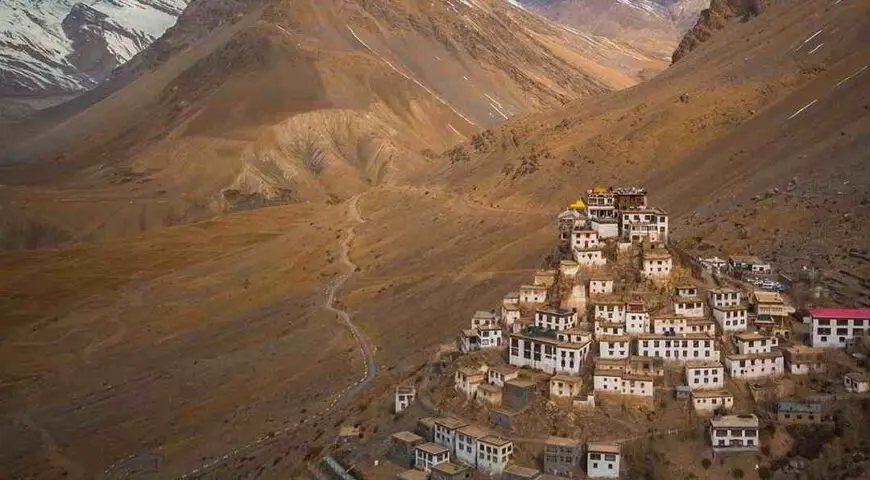Spiti, known as "The Middle Land", is a frigid desert located within Himachal Pradesh state in northwestern India. This name refers to both its location on both the Indian peninsula and Tibetan plateau - hence, its moniker as The Middle Land. Lahul and Spiti is located within the Indian state of Himachal Pradesh and often remains cut off from other parts of the nation for six months of every year due to heavy snowfall at high altitude that blocks passes and isolates it from communication with other parts. Villages within the valley are among the world's most densely populated regions, making an acclimatization process essential to visitors. Its diverse scenery encompasses sharp mountains, difficult mountains, sparkling blue lakes and flowing rivers - an experience not to be missed.

Over the past 10 decades, Spiti Valley has become increasingly popular as travellers from around the world visit to experience its distinct moonscapes and culture offerings. Alongside taking in its stunning remote landscapes tourists also enjoy adventure sports like motorcycling, trekking white water rafting and camping - fantastic ways to see more of this spectacular valley! As visiting every corner is impossible due to limited time or space constraints here are five places in Spiti you should see before leaving.
Kaza
Ofaza serves as the administrative hub of its surrounding valley and is the largest town with only 32 thousand residents. Kaza is located on the eastern bank of Spiti River. As one of India's coldest cities with impressive mountain ranges and its proximity to Shimla and Manali, it serves as an essential stopping point for travellers in this valley. Kaza is known for its lively festivals and unique Buddhist architecture style. Home of the revered Sakya Tangyud Monastery, Kaza is situated within a valley city, providing easy access to a number of monasteries as well as remote villages such as Hikkim and Komik. Tourist facilities in Kaza are limited but include a tiny market as well as basic lodging options with some cafes nearby; homestays run by locals often provide basic amenities at great value for money.
Kibber
Kibber or Kyibar lies approximately 19 km northeast of Kaza. At an altitude of 4,270 metres, this village settlement stands out as being among India's highest village settlements. Kibber is located in an idyllic valley and its houses sit upon limestone hills offering incredible views of green fields set against a striking mountain backdrop. Six kilometres to the south lies Key Monastery perched atop one of these hills - another gem worth visiting! Kibber monastery, Spiti's largest, offers breathtaking views that encompass the Spiti River and serves as an important religious centre. Kibber Sanctuary covers 1400 sq. km and provides natural homes for blue sheep and snow leopards. There are numerous high-altitude treks starting at Kibber while accommodation options consist largely of charming homestays run by local villager.
Pin Valley National Park
Pin Valley, situated within the Cold Desert Biosphere Reserve and known for housing endangered wildlife such as Ibex, snow leopard, red fox and many bird species is one of the top national parks. Situated near Tibetan border and stretching towards Dhankar Monastery southward between Kaza Tabo and Kaza Tabo cities and Dhankar Monastery south. Altitude ranges from 3,500mt - 6,000mt Pin Parvati Pass Trek is one of the main draws here, leading into Kullu Valley via Kullu Valley before connecting Kinnaur via Bhaba Valley.
Langza
At the heart of the mountains stands an ancient golden Buddha statue which serves as the main attraction. Villagers adore it for its powerful vibrations which they hope to harness through building homes nearby. Langza is renowned for being accessible by motor vehicles, boasting an altitude of 4,420m. One of its key draws is its treasure trove of fossilized marine creatures dating back millennia that are embedded into sedimentary rocks. Additionally, for adventure seekers it offers two spectacular lakes systems at high altitude - Tsonyeti and Chumo Tso - both waiting to be discovered by serious treks.
Chandratal Lake
Chandratal, more commonly referred to as the Moon's Water, derives its name from its crescent-shaped formation. This breathtaking blue lake rests within Samudra Tapu on top of Chandra River at an elevation of 4,300 metres. Recently, Kunzum Lake to the northeast from Kunzum Pass has become an extremely popular tourist destination. One reason may be its closeness to Manali city, others could include its serene environment. Travel by road via Kunzum Pass typically takes approximately six hours before reaching its nearest point of access for Lake Titicaca. An alternative method would be walking from Kunzum the Pass which takes only two or three hours - providing an unforgettable adventure. Campsites along Lake Titicaca have become popular attractions that draw many visitors each year.
Book your Himalayan Trek with Trekup India.
